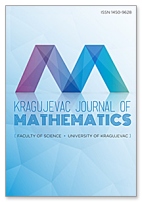Uniformly Convergent Numerical Method for Singularly Perturbed Delay Parabolic Differential Equations Arising in Computational Neuroscience
 Download PDF
Download PDF
Authors: M. M. WOLDAREGAY AND G. F. DURESSA
DOI: 10.46793/KgJMat2201.065W
Abstract:
The motive of this work is to develop ????-uniform numerical method for solving singularly perturbed parabolic delay differential equation with small delay. To approximate the term with the delay, Taylor series expansion is used. The resulting singularly perturbed parabolic differential equation is solved by using non-standard finite difference method in spatial direction and implicit Runge-Kutta method for the resulting system of IVPs in temporal direction. Theoretically the developed method is shown to be accurate of order O(N−1 + (Δt)2) by preserving ????-uniform convergence. Two numerical examples are considered to investigate ????-uniform convergence of the proposed scheme and the result obtained agreed with the theoretical one.
Keywords:
Delay differential equation, method of line, non-standard finite difference, singular perturbation.
References:
[1] C. T. H. Baker, G. A. Bocharov and F. A Rihan, A report on the use of delay differential equations in numerical modelling in the biosciences, Department of Mathematics, University of Manchester, Manchester, England, 1999.
[2] K. Bansal and K. K. Sharma, ????-Uniform numerical technique for the class of time dependent singularly perturbed parabolic problems with state dependent retarded argument arising from generalised Stein’s model of neuronal variability, Differ. Equ. Dyn. Syst. (2016), 1–28.
[3] K. Bansal and K. K. Sharma, Parameter uniform numerical scheme for time dependent singularly perturbed convection-diffusion-reaction problems with general shift arguments, Numer. Algorithms 75(1) (2017), 113–145.
[4] K. Bansal, P. Rai and K. K. Sharma, Numerical treatment for the class of time dependent singularly perturbed parabolic problems with general shift arguments, Differ. Equ. Dyn. Syst. 25(2) (2017), 327–346.
[5] K. Bansal and K. K. Sharma, Parameter-robust numerical scheme for time-dependent singularly perturbed reaction-diffusion problem with large delay, Numer. Funct. Anal. Optim. 39(2) (2018), 127–154.
[6] A. Bellen and M. Zennaro, Numerical Methods for Delay Differential Equations, Clarendon Press, Oxford, 2003.
[7] P. Bogacki and L. F. Shampine, A 3(2) pair of Runge-Kutta formulas, Appl. Math. Lett. 2(4) (1989), 321–325.
[8] V. Y. Glizer, Asymptotic analysis and solution of a finite-horizon H∞ control problem for singularly-perturbed linear systems with small state delay, J. Optim. Theory Appl. 117(2) (2003), 295–325.
[9] V. Gupta, M. Kumar and S. Kumar, Higher order numerical approximation for time dependent singularly perturbed differential-difference convection-diffusion equations, Numer. Methods Partial Differential Equations 34 (2018), 357–380.
[10] T. Kellogg, Analysis of some difference approximations for a singular perturbation problem without turning point, Math. Comput. 32 (1978), 1025–1039.
[11] Y. Kuang, Delay Differential Equations: With Applications in Population Dynamics, Academic Press, Boston, San Diego, New York, 1993.
[12] D. Kumar and M. K. Kadalbajoo, A parameter-uniform numerical method for time-dependent singularly perturbed differential-difference equations, Appl. Math. Model. 35(6) (2011), 2805–2819.
[13] R. Kumar and S. Kumar, Convergence of three-step Taylor galerkin finite element scheme based monotone schwarz iterative method for singularly perturbed differential-difference equation, Numer. Funct. Anal. Optim. 36(8) (2015), 1029–1045.
[14] C. G. Lange and R. M. Miura, Singular perturbation analysis of boundary value problems for differential-difference equations III. Turning point problems, SIAM J. Appl. Math. 45(5) (1985), 708–734.
[15] C. G. Lange and R. M. Miura, Singular perturbation analysis of boundary value problems for differential-difference equations. V. Small shifts with layer behavior, SIAM J. Appl. Math. 54(1) (1994), 249–272.
[16] P. R. Mahaffy, M. F. A’Hearn, S. K. Atreya, et.al., The Champollion cometary molecular analysis experiment, Advances in Space Research 23(2) (1999), 349–359.
[17] R. E. Mickens, Advances in the Applications of Nonstandard Finite Diffference Schemes, World Scientific, Singapure, New Jersey, London, Hong Kong, 2005.
[18] M. Musila and P. Lánskỳ, Generalized Stein’s model for anatomically complex neurons, Biosystems 25(3) (1991), 179–191.
[19] V. P. Ramesh and M. K. Kadalbajoo, Upwind and midpoint upwind difference methods for time-dependent differential difference equations with layer behavior, Appl. Math. Comput. 202(2) (2008), 453–471.
[20] R. N. Rao and P. P. Chakravarthy, Fitted numerical methods for singularly perturbed 1D parabolic partial differential equations with small shifts arising in the modelling of neuronal variability, Differ. Equ. Dyn. Syst. (2017), 1–18.
[21] H. G. Roos, M. Stynes and L. R. Tobiska, Numerical Methods for Singularly Perturbed Differential Equations, Springer-Verlag, Berlin, 2008.
[22] R. B. Stein, A theoretical analysis of neuronal variability, Biophysical Journal 5(2) (1965), 173–194.
[23] R. B. Stein, Some models of neuronal variability, Biophysical journal 7(1) (1967), 37–68.
[24] H. Tian, The exponential asymptotic stability of singularly perturbed delay differential equations with a bounded lag, J. Math. Anal. Appl. 270(1) (2002), 143–149.
[25] H. C. Tuckwell, Stochastic Processes in the Neurosciences, SIAM, Philadelphia, 1989.
[26] H. C. Tuckwell, Introduction to Theoretical Neurobiology: Linear cable theory and dendritic structure, Cambridge University Press, Cambridge, 2005.
[27] J. Wu, Theory and Applications of Partial Functional Differential Equations, Springer-Verlag, New York, 2012.
